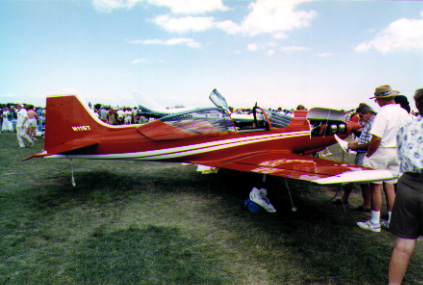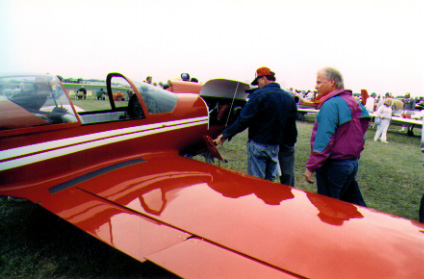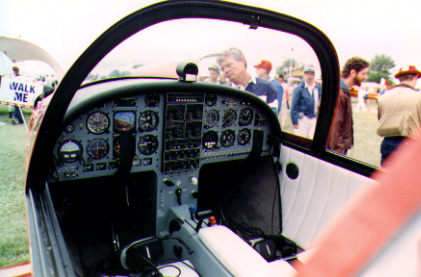First Flight:
Charles Gutzman
![]()
First Flight:
|
|
by Alfred Scott
|
This article appeared in the June 1990 issue of the Falco Builders Letter. |

At our Falco forum at Oshkosh last year, Charles Gutzman said that he was only a couple of weeks away from flying. Just a few little odds and ends remained to be done. Since Charles had built two airplanes before and is a highly skilled and experienced craftsman, I figured that he would be in the air in short order. It didn't work out that way, but he did get the Falco into the air on April 23. The problem was the paint job, and therein lies a long story.
Charles Gutzman is one of those quiet guys who likes to spend time in his workshop. He is a big man with years of experience making things, and he's got lots of brains in his head. He had built a Steen Skybolt, flew it for a while and then sold it. Then he built a Stephens Akro, flew it for a while in competition and became bored with solo flight, sold it and started the Falco.
Even though he built almost everything himself, he says he found the Falco easier to built than the Skybolt and Stephens Akro, simply because the plans were so complete and accurate. The hardest part of the Falco project was selecting the paint scheme. No kidding-he says the subject became so heated it almost broke up their marriage. Charles wanted a red Karl Hansen macho machine. Theresa was adamantly against that because it had already been done. She wanted a metallic grey airplane.
From the outside it was all terribly funny, and we finally resolved the matter by putting the Gutzmans in touch with Lu Matthews who designed the Falco paint schemes. Lu thought that both schemes were equally attractive, but reminded the Gutzmans that metallic paints create problems for the internal antenna system. This raised the possibility that they might end up with an airplane with external antennas, and that was enough to settle the matter.
So what we have here is a red Falco with white stripes and a Nustrini canopy. It's painted in Alumigrip Toreador Red polyurethane, and except for the numbers on the tail-N11ST-you can't tell it from Karl Hansen's machine.
The reason for the delay in getting the Falco into the air was the paint scheme. When Charles spoke at the Oshkosh forum, the Falco was already painted. He had sprayed the paint himself and wasn't particularly happy with it. The finish was a little dusty in places, and so he decided to sand it all down and shoot it again. This time he got a professional painter to spray the plane.

It was a disaster. When Theresa Gutzman walked into the hangar and saw the plane, she literally broke down and cried. There were runs four feet long on the sides of the plane, and it looked so bad that the painter has never had the nerve to send Charles a bill for the work.
So he broke out the sandpaper and sanded it back down to the primer again. The third spraying was done by Charles Gutzman, and he's still bothered by a few areas that look a little dusty, but this one is the last one.
This Falco came in relatively heavy, weighing about 1300 lbs empty. That's partly because of all the paint, but also because of the interior and avionics.
The instrument panel is spectacular, and it's ironic that this largely plans-built Falco has more avionics in it than has ever been installed in any Falco. There's a full Collins IFR package of dual nav/coms, transponder, ADF, marker beacon, DME, rnav, loran, a Century NSD-360 HSI and a Century I autopilot with tracker tied to the navs, rnav and loran. He's got everything in there but a Stormscope. In order to accomplish this, Charles had to redesign the front fuel tank, and he lost five gallons in the process.
The combination of colors and materials used for the interior is stunning. The instrument panel and console is painted in a flat medium grey paint, and there a slightly darker grey carpet on the floor and luggage compartment floor.
Some of you may have seen our yet-unfinished construction manual chapter on upholstery. In writing this, I picked the brains of a lot of experts, and came up with a number of conclusions on an overall philosophy as well as detailed designs of the various components. Charles said he agreed with everything in the chapter, and you can see the results in this plane.
The basic concept is to accept that the appearance of the Falco is dominated by the paint scheme on the outside and the instrument panel in the cockpit, and that the cockpit is also part of the outside of the airplane. Thus the upholstery should be monochromatic and should not try to compete for the eye's attention, but rather it should make everything work together visually. The interior in Charles's Falco executes this concept perfectly, and I would particularly like to draw your attention to the way the side panels stop at the front and how the walls and floor in front of that are covered with carpet.
With his experience in the Skybolt and Stephens Akro, Charles was well qualified for the first flight, which he did himself. It all went well, but on subsequent flights he had some problems with the retraction system. The circuit breaker was popping on gear-up, but he re-adjusted the up limit switch, and it now works fine. He has all of the gear doors except for the nose gear bay doors.

Charles had never flown a Falco before but reports that it's a "real agile airplane, but it has no manners when it stalls." He doesn't have stall strips on the plane and reports-as has everyone else-that there's no warning at all.
Well, come on, Charles, do you like it?
"Oh, yeah. It's a keeper."
Charles Gutzman is not a real talkative type, but he did say that he ran into a problem with the flaps. It happened with about 10 hours on the plane. He was climbing out at 85 knots indicated and then when he leveled off, the flaps started humming. He could see the right flap was buzzing up and down. He slowed the plane and that helped a little, but then he put the flaps down a few degrees. This stopped the buzzing/flutter, and he landed without incident.
Charles asked me to warn all of you that the two flap torque tubes must be bolted together to keep this from happening, and then was a little embarrassed when I pointed out that the plans show that. Somehow, he had missed that detail. I find this interesting because I have sometimes wondered in the cross-bolting was superfluous with the way we attach the torque tube to the actuator. It's quite clear from Charles's experience that the bolts are a necessary part of the design.
The only other problem he has is with the cabin ventilation. He put the two scoops on each side and for some reason no air comes in, even when they are wide open. These are the same vents that others have installed on their Falcos and which have worked well, but these are installed one station aft. Charles thinks it may be something to do with the flatness of the floor of the scoops.
This is the 28th Sequoia Falco to fly, and it has a 160 hp IO-320-B1A. The best speed he's seen so far is 198 mph true at 4500' and balls to the wall, but he has had some fuel injector problems and hopes to get the speed up a little. As I write this, Charles has 14 hours on the plane and plans to bring it to Oshkosh.
Charles and Theresa Gutzman live in Petersburg, Illinois, and they keep the Falco at the Springfield airport and the next hangar to them houses John Kerasotas's Falco, so this airport now joins the Grants Pass, Oregon, airport as the only airports in the U.S. with two Falcos based on the field.
|
|